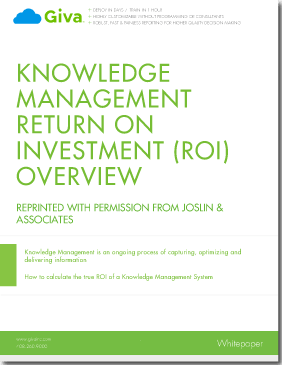Knowledge Management Return On Investment (ROI) Overview

Calculating Return-on-Investment (ROI) for Knowledge Base Software & Self-help Tools. Summary and Formulas for Knowledge Management System ROI.
Knowledge Management is an ongoing process of capturing, optimizing and delivering information
How to calculate the true ROI of a Knowledge Management System
Knowledge Management is an ongoing process of capturing, optimizing, and delivering information. It is not a one-time purchase of a new support center tool. Therefore to calculate the Return On Investment, you need to evaluate the cost of implementation and the cost of management. The cost of implementation relates to the initial purchase of software, hardware, communications, training, and services required for the knowledge base to be placed into production for daily use. The cost of management relates to the ongoing costs of maintaining the knowledge base and the infrastructure that was implemented.
While most support center managers are able to forecast the costs, they struggle to forecast the savings. This is partially because a number of the benefits of Knowledge Management are defined as soft dollars. Companies struggle to put a value on customer satisfaction, job satisfaction, quality service, or even the intellectual capital that is captured into the knowledge base. Another reason companies struggle is because they lack a benchmark. Before you can forecast an improvement, you have to know where you are.
Once you understand your current state, you must make reasonable forecasts regarding the impact Knowledge Management will have on your organization. The Knowledge Management vendors may offer to assist you with developing your ROI. Some vendors provide well-tuned and complex models. To simplify things, let's examine how some of the benefits can actually be converted to dollars. Before we begin, we need to make some assumptions about the support center. While these numbers may vary in your organization, the assumptions provide an example for this discussion.
Assumptions:
- Number of cases per month is 5000
- Average cost per case is $40.00.
- Average cost per escalated case is $150.00
- Average burdened cost for a support professional is $70,000.00
- Average talk time for first contact is 12 minutes
- Average talk time for escalated calls 18 minutes
- Time require for a new hire to be productive is 6 weeks
- Number of new hires per year 8
- First call resolution rate is 40%
Now let's examine how we might calculate a monthly return. You may want to modify these to focus on quarterly or annual impacts. When doing so, it is recommended that you adjust your forecasted improvements based on your expectations of the adoption rate and implementation plans.
Reducing the Average Call Time on first contact
- Forecasted improvement: 1 minute
- Savings = (Cases per month * Cost per case) * (Improvement / Talk Time for first contact)
- Savings = (5000 * $40) * (1/12)
- Savings = $16,667 per month
Increasing the First Call Resolution Rate
- Forecasted improvement: 20%
- Savings = (Cases per month * Improvement) * ((Escalated Talk Time - Talk Time for first contact) / Talk Time for first contact) * Cost per call
- Savings = (5000 * 20%) * ((18 - 12) / 12) * $40
- Savings = $20,000 per month
Reducing the Escalation Rate
- Forecasted improvement: 5%
- Savings = (Cases per month * Improvement) * (Cost per escalated case - Cost per case)
- Savings = (5000 * 5%) * ($150.00 - $40)
- Savings = $27,500 per month
Reducing the time required for a new support professional to become productive
- Forecasted improvement: 3 weeks
- Savings = ((Improvement * Number of new hirers per year) * (Average burdened cost of a support professional / weeks per year)) / months per year
- Savings = ((3 * 8) *($70,000 / 52)) / 12
- Savings = $2,692 per month
Redirecting repeat calls to Self-Service
- Forecasted improvement: 10% of current cases redirected to self-service
- Savings = (Improvement * Cases per month) * Cost per case
- Savings = (10% * 5000) * $40
- Savings = $20,000 per month
Developing an ROI for Knowledge Management in your support center depends on your current state, your implementation plans, your team, and your customers. The need for a formal ROI depends heavily on the senior management responsible for the support center. Some companies have minimized this focus because of an existing strong support from senior managers for Knowledge Management. Industry research groups such as Gartner, Forrester, Yankee, and others have well documented the value of Knowledge Management in the support center.